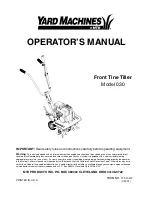
RLC-SVX14H-GB
90
Parts Ordering Information
Obtain the required parts from your local Trane Parts
Center.
Chemical Cleaning Procedure
•
Scale deposits are best removed by chemical means.
Consult a qualifi ed water treatment specialist (i.e., one
that knows the local water supply chemical/mineral
content) for a recommended cleaning solution suitable
for the job. (A standard condenser water circuit is
composed solely of copper, cast iron and steel.)
Improper chemical cleaning can damage tube walls.
Table 31 - Connection devices
Unit
Product
RTWD/RTUD - All units
Safety Hoist Ring M12x1.75
•
All of the materials used in the external circulation
system, the quantity of the solution, the duration
of the cleaning period, and any required safety
precautions should be approved by the company
furnishing the materials or performing the cleaning.
Note: Chemical tube cleaning should always be followed
by mechanical tube cleaning with R134a, OIL00317
on HSE version with 134a and OIL066E or OIL067E
for R1234ze.
Compressor Oil
CAUTION Equipment Damage!
To prevent oil sump heater burnout, open the unit main
power disconnect switch before removing oil from the
compressor.
Trane Polyolester Oil is the approved oil for the RTWD/
RTUD units. Polyolester oil is extremely hygroscopic
meaning it readily attracts moisture. The oil can not
be stored in plastic containers due to the hygroscopic
properties. As with mineral oil, if water is in the system
it will react with the oil to form acids. Use Table 32 to
determine the acceptability of the oil.
Trane approved oil :
R134a : OIL048E and OIL023E on SE, HE, XE version -
OIL 00317 for HSE version with AFD.
R1234ze: OIL066E and OIL067E.
The proper charge amounts are given in general data
tables.
Note: Use an oil transfer pump to change the oil
regardless of chiller pressure.
Table 32 - POE Oil Properties
Description
Acceptable levels
Moisture content
Less than 300 ppm
Acid level
Less that 0.5 TAN (mg KOH/g)
Oil Sump Level Check
Running the chiller at minimum load is the best for
the quickest return of oil to the separator and sump.
The machine still needs to sit for approximately 30
minutes before the level is taken. At minimum load, the
discharge superheat should be highest. The more heat
in the oil as it lays in the sump, the more refrigerant will
boil off in the sump and leave more concentrated oil.
The oil level in the oil sump can be measured to give
an indication of the system oil charge. Follow the
procedures below to measure the level.
1. Run the unit fully unloaded for approximately
20 minutes.
2. Cycle the compressor off line.
CAUTION Oil Loss!
Never operate the compressor with the sightglass service
valves opened. Severe oil loss will occur. Close the
valves after checking the oil level. The sump is above the
condenser and it is possible to drain the oil.
Figure 23 - Determining Oil Level in Sump
A = Oil separator service valve
B = Oil sump service valve
C = 10-24cm
3. Attach a 3/8” or 1/2” hose with a sightglass in the
middle to the oil sump service valve (1/4” fl are) and
the oil separator service valve (1/4” fl are).
Note: Using high pressure rated clear hose with
appropriate fi ttings can help speed up the process.
4. After the unit is off line for 30 minutes, move the
sightglass along the side of the oil sump.
5. The level should be between 10-24 cm from the
bottom of the oil sump. If the level appears to be
above 24 cm, the oil sump is completely full. Most
likely more oil resides in the rest of the system and
some oil needs to be removed until the level falls
between 10-24 cm in the oil sump.
Note: Nominal height of oil is 20 cm.
Service and Maintenance







































